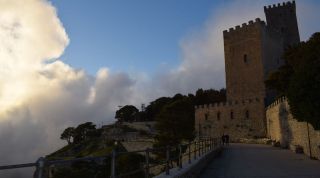As you can see the top of Erice mountain covered by a cloak of fog, tradition says that Venus, the goddess of love, comes back to her residence.
Between the VI and the V century B.C. an Elymian settlement was created. The Elymians were the first inhabitants to settle Erice between the 6th and the 5th century B.C. The myth of the foundation of this population dates back to the war of Troy , Anatolian city where they came from. Different names have been attributed to the protective goddess of Erice: the relationship between the people who lived in Erice and the sanctuary was very deep. She was worshipped as Potnia Theron, which means goddess of the Mother Heart, as Astarte, the Phoenician-Punic goddess, Aphrodite, the Greek one, and Venus, the equivalent figure in the Roman Pantheon. The cult suddenly became panmediterranean and included practices of holy prostitution by the priestess of the temple.
The fame of Erice’s Venus extended overseas and even reached Rome, which dedicated two sanctuaries to her. Eliano and Ateneo, Greek historians who lived between the 2nd and the 3rd century B.C., wrote about some twin festivals between Erice and Libia. They were called anagogìe and katagogìe, and marked the two moments of departure and arrival of the holy pigeons.
From the Norman period the city assumed the look we can see nowadays: an amazing medieval village with stone buildings. As you walk through the streets, you will see the Cyclopian masonry, the odour of cooking will make your mouth water, you’ll discover the courtyard full of flowers, as they were during the arab domination. Erice is a paradise you can reach just by taking the cable car. Remember to check the time table before you go by visiting the following link: http://www.funiviaerice.it
And don’t forget to admire the view of the sunset over Trapani, as you leave Erice by cable car!

Roberta Di Rosa
Licensed tour guide
Book a trip or a tour now
Call me or send me an e-mail
+39.329.1263.099info@robertadirosa.com

